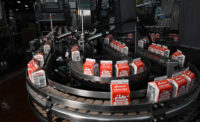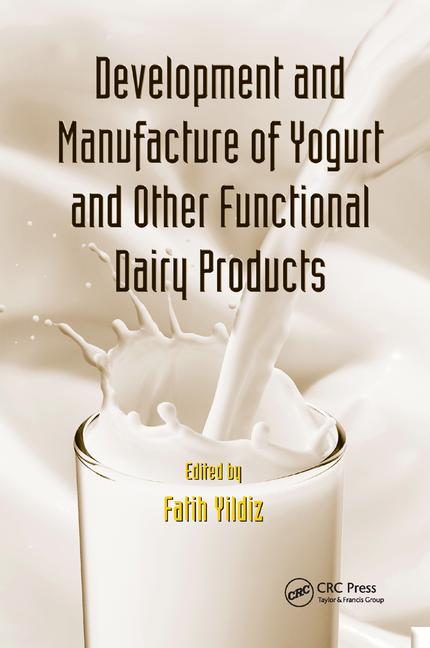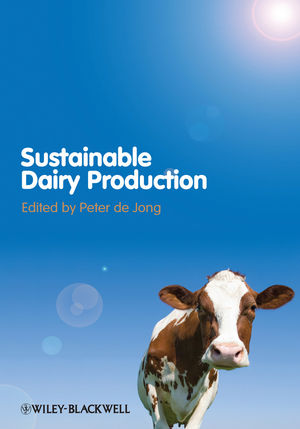Keeping It All Together
Equipment for casing, stacking and palletizing keeps dairy products safe, neat and protected from damage on the loading dock, in transit and at their destination.

 A stack-and-wrap process combines two or more lines into a centralized automated palletizing/stretch-wrapping station. While conveyors deliver an empty pallet to each stretch wrapper, product is delivered from two production lines to the palletizing cell. The robotic arm builds layers of product on each of the wrappers. The palletizing system was engineered by Schneider Packaging Equipment (www.schneiderequip.com) with stretch wrappers from Lantech (www.lantech.com).
A stack-and-wrap process combines two or more lines into a centralized automated palletizing/stretch-wrapping station. While conveyors deliver an empty pallet to each stretch wrapper, product is delivered from two production lines to the palletizing cell. The robotic arm builds layers of product on each of the wrappers. The palletizing system was engineered by Schneider Packaging Equipment (www.schneiderequip.com) with stretch wrappers from Lantech (www.lantech.com).
The economical and compact adhesive top case sealer has a heavy-gauge stainless steel frame, continuous motion side belt case drive and contoured flap folders to ensure square cases. Model 136HM sealer from A-B-C Packaging Machine (www.abcpackaging.com) is built for drop-in installation on a standard 15-inch line elevation. It can adjust to a full range of case sizes from 8 inches long by 6 inches wide by 5 1/4 inches high to a maximum of 24 inches by 16 inches by 17 inches high.
The Trayfecta tray former from Delkor (www.delkorsystems.com) automatically forms and glues a variety of retail-ready display trays at a speed of 35 trays per minute. The former is designed so it can feed into a variety of the company’s packaging lines. One packaging line can produce multiple shipper styles. Changeover is controlled by a single touch screen HMI. In a demonstration, a line was converted from running a Spot-Pak package to the retail-ready display tray. The changeover was completed in 10 seconds and the filler did not have to be turned off. The Trayfecta Retail Ready Former has a compact footprint and is equipped with Allen Bradley controls. Stainless steel construction is standard.
Krones’ Checkmat 761 CR-CX (www.krones.com) uses X-rays to verify that the complete number of primary packs are present in a sealed carton. In addition, four cameras check all four sides of the carton for correct label positioning, correct barcode and correctly applied sealing tape. The combination of X-ray and camera-based monitoring enables complete end-of-the-line inspection to be performed.
Processors seek more economical and efficient means of packaging. Polypack’s (www.polypack.com) shrink bundlers eliminate cardboard cases and traditional plastic milk crates. Gable-top milk cartons are shrink-wrapped with cardboard inserts strategically placed between the rows to give added stacking strength to the bundle packs. These bundles are palletizable and significantly reduce waste in schools, hospitals and other institutions because there are no more boxes to be broken down and thrown out. This also means there are no more heavy plastic milk crates to hose down and stack for the delivery driver.
Legacy 3 from Oystar Jones (www.oystar.rajones.com) is a constant-motion, small-center cartoner. The machine’s flexibility allows a wide range of cartoning at speeds as great as 400 cartons a minute. Featured upgrades, according to the company, include an ergonomically designed straight-in, low-level carton magazine, quick changeovers (thanks to tool-less adjustments) and a variable-velocity carton feed design. A “quick clean” bucket conveyor eliminates catch points and provides full visual compliance.
Model FL1000-SW from Columbia Machine (www.palletizing.com) combines a heavy-duty, small-footprint palletizer with a fully integrated stretch wrapper. With no modification, the machine can simultaneously stack and stretch-wrap a wide variety of package types, including cases, trays, totes, film-only and display packs for the beverage and frozen food industries. The FL1000-SW palletizes 10 cases a minute (10 case per layer pattern) or more, depending on the case size and pallet pattern.
Hexacomb Billboard from Pregis (www.hexacomb.com) is a pallet alternative that incorporates an additional outer edge wrap. It consists of kraft paper layers laminated to a white clay-coated outer surface onto which logos, brands or store names can be flexographically printed in a repeating pattern. A logo on a pallet is particularly valuable for products sold in warehouse stores. In addition to providing a branding platform, the edge wrap also improves pallet strength and durability. The use of 80% virgin fibers and the wrapped fiberboard feet help make the pallets water resistant. Each pallet can handle static loads of up to 6,000 pounds.
Westfalia Technologies’ (www.westfaliausa.com) new dairy case palletizing system is capable of handling plastic and wood pallets. The system palletizes two full pallets per minute. Each pallet holds nine stacks of dairy cases stacked six high for a total of 54 cases on each pallet. Constructed of all stainless steel materials, it is ideally suited for washdown environments found in the dairy and beverage industries.
Phoenix (www.phoenixwrappers.com) offers a new, more affordable rotary ring stretch-wrapping machine that is said to reduce labor and film costs. The new line uses a unique wrapping ring concept that eliminates the need for extra film passes up the load to secure top wraps and then back down to the clamp for final tail treatment. This process produces a savings of at least 30 feet of stretch film while still applying the same required load retention wraps, the company states. There are two small footprint models; one rated at 40 rpm and 100 or more loads per hour and the other rated at 21 rpm, 70-plus loads per hour. Both offer an 80-inch wrap height capacity.
The Econoseal E-System 2000 from Econocorp (www.econocorp.com) can accommodate 1,500 paperboard or corrugated cartons per hour. The base machine, including a hot melt glue system or tuck closure system, handles a broad range of carton sizes and takes up minimal floor space. The ergonomically friendly machine automatically erects cartons onto a single product loading station. It allows an operator to load product with the help of a stainless steel guide shelf, or can be equipped with optional automatic product loading conveyors and devices. Date/lot coding devices and other options can be incorporated into the design. The basic machine frame is 60 inches long by 32 inches wide.
QComp Technologies (www.qcomptech.com) and Combi Packaging Systems (www.combi.com) have partnered on high-speed picker and case packing systems. QComp’s high-speed (Delta-style robot) picker systems complement Combi’s case and tray packing machines. QComp is a robotics integrator that designs and builds automated robotic manufacturing cells and materials handling systems. Combi Packaging Systems is a maker of end-of-line packaging equipment, including case erectors, tray erectors, case sealers, case packers, ergonomic hand-packing stations and case labelers.


The economical and compact adhesive top case sealer has a heavy-gauge stainless steel frame, continuous motion side belt case drive and contoured flap folders to ensure square cases. Model 136HM sealer from A-B-C Packaging Machine (www.abcpackaging.com) is built for drop-in installation on a standard 15-inch line elevation. It can adjust to a full range of case sizes from 8 inches long by 6 inches wide by 5 1/4 inches high to a maximum of 24 inches by 16 inches by 17 inches high.
The Trayfecta tray former from Delkor (www.delkorsystems.com) automatically forms and glues a variety of retail-ready display trays at a speed of 35 trays per minute. The former is designed so it can feed into a variety of the company’s packaging lines. One packaging line can produce multiple shipper styles. Changeover is controlled by a single touch screen HMI. In a demonstration, a line was converted from running a Spot-Pak package to the retail-ready display tray. The changeover was completed in 10 seconds and the filler did not have to be turned off. The Trayfecta Retail Ready Former has a compact footprint and is equipped with Allen Bradley controls. Stainless steel construction is standard.
Krones’ Checkmat 761 CR-CX (www.krones.com) uses X-rays to verify that the complete number of primary packs are present in a sealed carton. In addition, four cameras check all four sides of the carton for correct label positioning, correct barcode and correctly applied sealing tape. The combination of X-ray and camera-based monitoring enables complete end-of-the-line inspection to be performed.
Processors seek more economical and efficient means of packaging. Polypack’s (www.polypack.com) shrink bundlers eliminate cardboard cases and traditional plastic milk crates. Gable-top milk cartons are shrink-wrapped with cardboard inserts strategically placed between the rows to give added stacking strength to the bundle packs. These bundles are palletizable and significantly reduce waste in schools, hospitals and other institutions because there are no more boxes to be broken down and thrown out. This also means there are no more heavy plastic milk crates to hose down and stack for the delivery driver.
Legacy 3 from Oystar Jones (www.oystar.rajones.com) is a constant-motion, small-center cartoner. The machine’s flexibility allows a wide range of cartoning at speeds as great as 400 cartons a minute. Featured upgrades, according to the company, include an ergonomically designed straight-in, low-level carton magazine, quick changeovers (thanks to tool-less adjustments) and a variable-velocity carton feed design. A “quick clean” bucket conveyor eliminates catch points and provides full visual compliance.
Model FL1000-SW from Columbia Machine (www.palletizing.com) combines a heavy-duty, small-footprint palletizer with a fully integrated stretch wrapper. With no modification, the machine can simultaneously stack and stretch-wrap a wide variety of package types, including cases, trays, totes, film-only and display packs for the beverage and frozen food industries. The FL1000-SW palletizes 10 cases a minute (10 case per layer pattern) or more, depending on the case size and pallet pattern.
Hexacomb Billboard from Pregis (www.hexacomb.com) is a pallet alternative that incorporates an additional outer edge wrap. It consists of kraft paper layers laminated to a white clay-coated outer surface onto which logos, brands or store names can be flexographically printed in a repeating pattern. A logo on a pallet is particularly valuable for products sold in warehouse stores. In addition to providing a branding platform, the edge wrap also improves pallet strength and durability. The use of 80% virgin fibers and the wrapped fiberboard feet help make the pallets water resistant. Each pallet can handle static loads of up to 6,000 pounds.
Westfalia Technologies’ (www.westfaliausa.com) new dairy case palletizing system is capable of handling plastic and wood pallets. The system palletizes two full pallets per minute. Each pallet holds nine stacks of dairy cases stacked six high for a total of 54 cases on each pallet. Constructed of all stainless steel materials, it is ideally suited for washdown environments found in the dairy and beverage industries.
Phoenix (www.phoenixwrappers.com) offers a new, more affordable rotary ring stretch-wrapping machine that is said to reduce labor and film costs. The new line uses a unique wrapping ring concept that eliminates the need for extra film passes up the load to secure top wraps and then back down to the clamp for final tail treatment. This process produces a savings of at least 30 feet of stretch film while still applying the same required load retention wraps, the company states. There are two small footprint models; one rated at 40 rpm and 100 or more loads per hour and the other rated at 21 rpm, 70-plus loads per hour. Both offer an 80-inch wrap height capacity.
The Econoseal E-System 2000 from Econocorp (www.econocorp.com) can accommodate 1,500 paperboard or corrugated cartons per hour. The base machine, including a hot melt glue system or tuck closure system, handles a broad range of carton sizes and takes up minimal floor space. The ergonomically friendly machine automatically erects cartons onto a single product loading station. It allows an operator to load product with the help of a stainless steel guide shelf, or can be equipped with optional automatic product loading conveyors and devices. Date/lot coding devices and other options can be incorporated into the design. The basic machine frame is 60 inches long by 32 inches wide.
QComp Technologies (www.qcomptech.com) and Combi Packaging Systems (www.combi.com) have partnered on high-speed picker and case packing systems. QComp’s high-speed (Delta-style robot) picker systems complement Combi’s case and tray packing machines. QComp is a robotics integrator that designs and builds automated robotic manufacturing cells and materials handling systems. Combi Packaging Systems is a maker of end-of-line packaging equipment, including case erectors, tray erectors, case sealers, case packers, ergonomic hand-packing stations and case labelers.
Looking for a reprint of this article?
From high-res PDFs to custom plaques, order your copy today!







